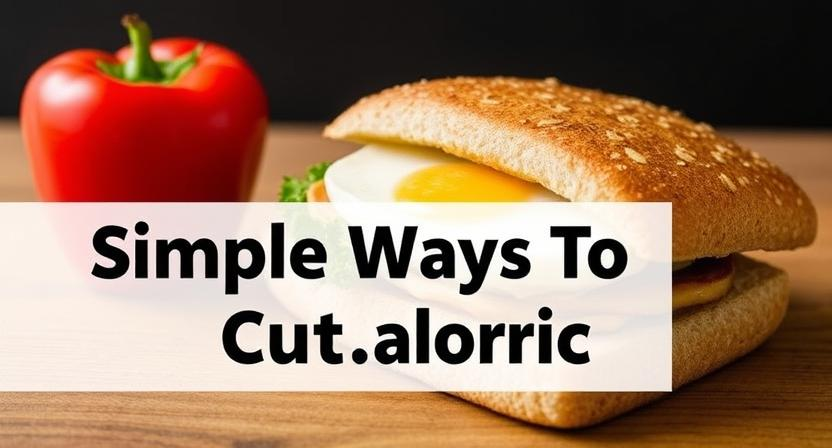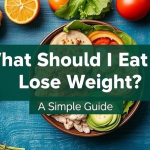When people think about cutting calories, the first thing that often comes to mind is deprivation. Visions of sad salads, skipped meals, and a grumbling stomach seem to go hand-in-hand with the idea of weight loss. But here’s the truth: you don’t have to starve yourself to cut calories. In fact, making small, smart choices throughout your day can help you reduce your calorie intake without sacrificing satisfaction or nutrition.
Let’s dive into some surprisingly simple strategies that can help you cut calories, feel full, and still enjoy the food you love.
1. Rethink Your Drinks
One of the sneakiest sources of empty calories comes from what we drink. A regular soda, sweetened coffee drinks, fruit juices, and even some “healthy” smoothies can pack hundreds of calories without making you feel full.
What to do instead:
- Switch to water, sparkling water, or herbal teas.
- Add lemon, cucumber, or berries to water for flavor without the calories.
- Try coffee with a splash of milk or plant-based creamer instead of sugary syrups.
By simply cutting out two sugary drinks a day, you could save over 300 calories—without changing a single thing about your meals.
2. Portion Control Without the Pain
You don’t need to weigh every bite or count every crumb to reduce portions. Often, just being mindful of how much you’re eating can make a huge difference.
Simple portion tips:
- Use smaller plates and bowls to naturally reduce serving sizes.
- Serve food from the kitchen instead of leaving dishes on the table.
- Fill half your plate with vegetables before adding other items.
You’ll still eat satisfying meals, but with fewer calories overall.
3. Bulk Up With Veggies
Vegetables are the ultimate calorie-cutting secret. They’re high in fiber and water, which help you feel full, but they’re also low in calories. Best of all, they’re incredibly versatile.
Ways to use veggies to your advantage:
- Add spinach, tomatoes, or peppers to your morning eggs or sandwich.
- Use cauliflower rice or zucchini noodles in place of grains or pasta.
- Load up soups, stews, and stir-fries with extra veggies.
By bulking up meals with vegetables, you can eat more volume and still cut calories.
4. Make Smart Swaps
Small food swaps can lead to big calorie savings over time, and you’ll barely notice the difference.
Examples of easy swaps:
- Greek yogurt instead of sour cream.
- Mashed avocado instead of mayonnaise.
- Air-popped popcorn instead of chips.
- Lettuce wraps instead of tortillas.
These swaps don’t feel like sacrifices—they just make your meals a little lighter while still tasting great.
5. Cut Down on Oil and Butter (Without Cutting Flavor)
Fats like oil and butter are calorie-dense. Just one tablespoon of oil has around 120 calories, and it’s easy to pour on more than you need.
How to scale back:
- Use non-stick pans or cooking sprays.
- Try baking, steaming, or air frying instead of deep-frying.
- Season with herbs, spices, vinegar, or lemon juice instead of heavy sauces.
Your food can still be full of flavor without being drenched in calories.
6. Slow Down and Tune In
We live in a fast-paced world, and that often carries over into how we eat. When you eat too quickly, your body doesn’t have time to register fullness until it’s too late. That can lead to overeating without even realizing it.
Mindful eating tips:
- Put down your fork between bites.
- Chew thoroughly and really savor the flavors.
- Avoid distractions like screens during meals.
By slowing down, you’ll likely find you’re satisfied with less food—and fewer calories.
7. Plan Snacks With Purpose
Snacking isn’t the enemy—it’s mindless snacking that can throw off your goals. It’s easy to grab chips, cookies, or candy between meals, but those calories add up fast.
Healthier snack ideas:
- A handful of almonds and an apple.
- Carrot sticks with hummus.
- Low-fat cheese with whole grain crackers.
Having a plan helps you avoid the vending machine and keeps you fueled with better choices.
8. Don’t Skip Meals
Ironically, skipping meals to save calories often backfires. It can lead to intense hunger later, which sets the stage for overeating or binging. It also slows down your metabolism and makes it harder to make smart food choices.
Instead:
- Eat balanced meals throughout the day.
- Include protein, healthy fats, and fiber in each meal to stay satisfied.
- Have a healthy snack ready if you’re going long hours between meals.
Keeping your body fueled keeps cravings under control and helps regulate appetite.
9. Stay Hydrated
Sometimes, we mistake thirst for hunger. If you’re feeling hungry soon after eating, try drinking a glass of water first. Hydration also helps your metabolism function efficiently and keeps digestion on track.
Tips to stay hydrated:
- Carry a water bottle with you.
- Set hourly reminders to take a sip.
- Drink a glass of water before each meal.
This small habit can help you naturally reduce how much you eat—without ever feeling deprived.
10. Don’t Aim for Perfection—Aim for Progress
Remember: cutting calories doesn’t mean cutting out joy, celebrations, or your favorite foods. It’s about making better choices most of the time, not all of the time. Enjoy your favorite dessert or comfort food occasionally—just balance it out with lighter choices elsewhere.
The key is consistency over perfection.
Final Thoughts
You don’t need to starve yourself to get healthier or lose weight. In fact, sustainable weight loss and long-term health come from balanced eating, smart habits, and a positive relationship with food. By making small, mindful adjustments—like swapping ingredients, controlling portions, and adding more veggies—you can lower your calorie intake while still loving what’s on your plate.
So next time you think “diet,” remember: it doesn’t have to mean deprivation. You can eat well, feel full, and still reach your goals—without ever feeling like you’re starving.






Leave a Reply